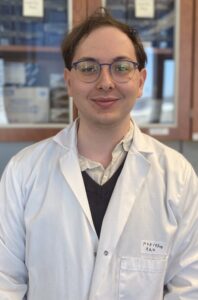Biomedical scientists apply observations of the natural world along with biological and physical scientific techniques to create interventions and develop technologies that improve healthcare and public health worldwide. Biomedical sciences apply the principles of these disciplines to topics related to infectious or non-infectious diseases that affect all humans.
Cell Biology
Cell biology studies the structure and functions of cells. This discipline looks at the physiological properties, metabolic processes, signaling pathways, life cycle, and interactions between cells in an organism and between cells and their environment. At John Jay, our students are trying to understand the function of genes that control cancer development and inflammatory disorders, and how microRNAs (short non-coding RNA molecules, also known as miRNAs, that bind messenger RNA) can affect gene expression.
Klaudia Baran
The Relationship Between Metabolic Genes and Chronic Pain (Dr. Angelique Corthals)
 The anatomy and physiology class I took during my senior year in high school sparked my fascination with the human body. My experience with PRISM has taught me that research isn’t just about protocols and goals; it’s about leveraging your curiosity and passion for a topic to advance knowledge. It has the potential to make the world a better place if you try hard enough. I plan to obtain an MD/PhD in pathology/regenerative medicine and pursue a career in forensic pathology and biomedical research.
The anatomy and physiology class I took during my senior year in high school sparked my fascination with the human body. My experience with PRISM has taught me that research isn’t just about protocols and goals; it’s about leveraging your curiosity and passion for a topic to advance knowledge. It has the potential to make the world a better place if you try hard enough. I plan to obtain an MD/PhD in pathology/regenerative medicine and pursue a career in forensic pathology and biomedical research.
My research focuses on finding a medically exploitable relationship between metabolic genes and the genes involved in inflammatory responses in chronic pain patients. Understanding this relationship will help pave the way towards a better life for those suffering from chronic pain.
Sylvia Bural
Interactions Between Green Tea Polyphenols and miRNAs (Dr. Lissette Delgado-Cruzata)
 I am fascinated by science and the discovery process, and I want to be a part of those future discoveries. Whether a small success or not, I know every scientific finding is crucial for the future, and each finding leads to a new experiment. I have learned that with passion comes an exuberant amount of work and that research prepares me to “expect the unexpected.” I aspire to be a medical scientist and conduct extensive research to discover cures or effective treatments for diseases. After graduating from John Jay, I will pursue a PhD. I have enjoyed connecting with peers who share my passion for science and making new connections as part of PRISM.
I am fascinated by science and the discovery process, and I want to be a part of those future discoveries. Whether a small success or not, I know every scientific finding is crucial for the future, and each finding leads to a new experiment. I have learned that with passion comes an exuberant amount of work and that research prepares me to “expect the unexpected.” I aspire to be a medical scientist and conduct extensive research to discover cures or effective treatments for diseases. After graduating from John Jay, I will pursue a PhD. I have enjoyed connecting with peers who share my passion for science and making new connections as part of PRISM.
Green tea contains powerful antioxidants like polyphenols. In my research, I study miRNAs in breast cancer cells after exposure to green tea-derived polyphenols like EGCG. By assessing changes in miRNA levels after exposure to these compounds, we can determine if they potentially reduce the cancerous properties in cells.
Ashley Kaswer
Ingenuity Pathway Analysis of the Impact of Mitomycins and Novel Indium-Containing Compounds on Cancer Cells (Dr. Shu-Yuan Cheng)
 My passion for science began in high school chemistry and has flourished since then throughout college. Over time, I’ve developed a deep fascination with toxicology, and I’m excited to continue expanding my knowledge and refining my skills in this field. Conducting research in PRISM has allowed me to channel this passion into meaningful projects that can make a real impact in the scientific community. After graduation, I’ll be starting my PhD in Pharmacology & Toxicology at Michigan State University, and I plan to use my expertise to become a forensic toxicologist and expert witness in court.
My passion for science began in high school chemistry and has flourished since then throughout college. Over time, I’ve developed a deep fascination with toxicology, and I’m excited to continue expanding my knowledge and refining my skills in this field. Conducting research in PRISM has allowed me to channel this passion into meaningful projects that can make a real impact in the scientific community. After graduation, I’ll be starting my PhD in Pharmacology & Toxicology at Michigan State University, and I plan to use my expertise to become a forensic toxicologist and expert witness in court.
We utilize bioinformatics pathway analysis to elucidate biological connections and pharmacological mechanisms in cancer drugs. Understanding these processes will aid researchers in developing more selective cancer treatments.
Genetics
Evolution results from changes in the genetic material, or genes, of a species over time. These genetic changes can provide adaptations that give an evolutionary advantage to the organism when faced with changes to its environment. Evolutionary genetics aims to identify changes in genes that lead to the evolution of species. At John Jay, our students compare the genes of primates to those of humans to understand what makes humans unique and study how urbanization affects the genetic diversity of invertebrates in NYC.
Olivia Fratangelo
Phylogenetic Analysis of the Role of miRNA in Human Evolution (Dr. Hunter Johnson)
 The contrast between the disciplines I am pursuing in my degree, computer science and philosophy, allows me to strengthen both my technical and creative skills while exploring the ethical and legal issues that come with modern technology. I’ve always been naturally curious and inclined toward science. I especially enjoyed taking AP biology in high school and am grateful to reconnect with my background in science while using my computer science skills. Participating in PRISM has pushed me out of my comfort zone and introduced me to many exciting new ideas and opportunities.
The contrast between the disciplines I am pursuing in my degree, computer science and philosophy, allows me to strengthen both my technical and creative skills while exploring the ethical and legal issues that come with modern technology. I’ve always been naturally curious and inclined toward science. I especially enjoyed taking AP biology in high school and am grateful to reconnect with my background in science while using my computer science skills. Participating in PRISM has pushed me out of my comfort zone and introduced me to many exciting new ideas and opportunities.
My lab studies the evolutionary significance of miRNA in humans. My project uses computational methods to examine the relationships between us and our ancient relatives, Neanderthals and Denisovans. I use phylogenetic trees to visualize this data, showing how miRNA have evolved over time in relation to their gene targets.
Marcellino Rau
Observing the In Vitro Effects of Epigallocatechin Gallate Treatment on Breast Cancer Genetics (Dr. Lissette Delgado-Cruzata)
 My passion for research began during my high school’s research program, where I explored clinical research on immunotherapy for colorectal cancer. Witnessing the challenges cancer patients face with the side effects of modern chemotherapy, I am eager to contribute to improving current cancer treatments and innovating new ones. After completing my undergraduate degree, I plan to pursue an MD/PhD in oncology. Although I have not yet decided which field of oncology to specialize in, I am particularly fascinated by cellular mechanisms and their systemic effects.
My passion for research began during my high school’s research program, where I explored clinical research on immunotherapy for colorectal cancer. Witnessing the challenges cancer patients face with the side effects of modern chemotherapy, I am eager to contribute to improving current cancer treatments and innovating new ones. After completing my undergraduate degree, I plan to pursue an MD/PhD in oncology. Although I have not yet decided which field of oncology to specialize in, I am particularly fascinated by cellular mechanisms and their systemic effects.
We are studying the effects of epigallocatechin gallate, a green tea-derived polyphenol, on breast cancer RNA production. Since most standard therapies are ineffective against triple-negative breast cancer, this research could pave the way for further innovations.



